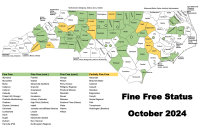WNC schools still recovering from Covid-era learning

New state testing results reveal that schools in Western North Carolina are in the process of a mixed recovery from COVID-era learning disruptions, something state officials say may take years.
The North Carolina Department of Public Instruction released data last week that shows test results, accountability and growth for all public schools in the state during the 2021-22 school year, the third year affected by the COVID-19 pandemic.
“Students and the education community continued to be affected by COVID, particularly when COVID exposures required students to be absent from school or revert to remote learning,” said Tammy Howard, DPI’s senior director for the office of accountability and testing. “These reports must be reviewed within that context, meaning, though instructional delivery was not as varied as in the 2020-21 school year, it continued to be an anomaly in comparison to the 2018-19 school year, which was prior to the onset of the pandemic.”
Even though testing and accountability data has been released every year since the late 1990s, testing data was not released for the 2019-20 or 2020-21 school years due to abnormalities in test administration and other data markers caused by the COVID-19 pandemic. The data shows that as of the 2021-22 school year, the percent of participation targets met did not recover to pre-pandemic rates.
The data gives every individual school a letter grade, A through F, based on each school’s achievement score from assessments such as end-of-grade and end-of-course tests, English language assessments, ACT scores, four-year graduation rates and students’ academic growth. The assessments account for 80% of the letter grade and growth accounts for 20%.
One third of all schools in North Carolina were designated as low-performing schools, receiving a grade of D or F.
Related Items
“While these results are sobering, they are not unexpected,” said Michael Maher, deputy Superintendent, division of standards, accountability and research at the NCDPI.
In The Smoky Mountain News’ coverage area, 10 out of 35 schools were designated as low-performing.
Academic growth, also determined for individual schools, is a measure of how far students progress academically during the school year. Each school with at least 30 students able to be included in the growth calculation is determined to have met growth standards, exceeded them, or not met them.
The data shows that 51.2% of students were proficient on state exams during the 2021-22 school year, compared with 45.4% during the 2020-21 school year, and 58.8% during the 2018-19 school year, the last school year prior to the pandemic.
The four-year high school graduation rate of students in North Carolina dropped to 86.2%, down from 86.9% in the 2020-21 school year and 87.6% in the 2019-20 school year. Haywood, Jackson, Macon and Swain counties maintained a graduation rate above the state average.
“We know that test scores alone are not sufficient to measure the performance of our students,” said State Board of Education member Jill Camnitz. “However, we also know that those test scores are important information for our students, parents, teachers, schools and districts. They reflect the tremendous efforts of our teachers to accelerate learning after covid. They provide our teachers with usable data this year so they can individualize their teaching to meet student needs and they also provide us with more information about the impact of covid on student learning across the state.”
Haywood
Haywood County Schools performed quite well relative to other systems in the state, rising to number seven of 115 school districts in academic performance, the highest in its history. During the 2020-21 school year, the system was ranked 10th.
“The recently released performance data represents our sense of urgency and our high expectations,” said Dr. Bill Nolte, Superintendent. “We tried to make every minute count. We are back within a composite point of our pre-COVID-19 performance. We will provide additional performance highlights at the September Board of Education meeting.”
Haywood County Schools was among only 10 school systems in the state that did not have a D or F school for the 2021-22 school year.
Riverbend Elementary and Haywood Early College received an A; Pisgah High, Tuscola High, Bethel Middle and Bethel Elementary received a B; Clyde, Hazelwood, Jonathan Valley, Junaluska, Meadowbrook and North Canton elementaries, Canton Middle, Waynesville Middle and Central Haywood High all received a C.
Eleven schools within the HCS system met growth standards; Waynesville Middle, Bethel Elementary and Hazelwood Elementary did not.
Haywood County Schools’ composite performance shows 63.4% of its students were proficient on state exams during the 2021-22 school year, well above the state average of 51.2%.
“I am so proud of our school system,” said Jill Barker, Assistant Superintendent for Curriculum and Instruction. “The data represents the perseverance, strength and heart of our entire school community. COVID-19 did not stop us from the important work of educating our students. Our system has remained intently focused on providing a strong education despite many obstacles. All of our stakeholders are to be commended.”
Jackson
In Jackson County, eight out of nine schools met or exceeded expected academic growth during the 2021-22 school year for the first time since 2013.
“This is the first time since 2013 that eight of our schools either met or exceeded expected overall academic growth,” Superintendent Dr. Dana Ayers said. “I am incredibly proud of our teachers and staff who stayed focused on their students during two of the most challenging years in recent memory.”
Jackson County Early College received a school performance grade A; Smoky Mountain High School received a B; Blue Ridge Early College and Fairview School received C’s; Blue Ridge School, Cullowhee Valley, Scotts Creek and Smoky Mountain Elementary received D’s.
Jackson County Early College, Scotts Creek and Smoky Mountain High School exceeded expected overall academic growth; Blue Ridge School, Blue Ridge Early College, Cullowhee Valley School, Fairview School and Smoky Mountain Elementary met expected overall academic growth.

- Students arrive at Smokey Mountain Elementary for the first day of the 2022-23 school year. David Proffitt photo
High points for Jackson County public schools include Scotts Creek Elementary, which ranked fifth out of 191 schools in the western region for overall school growth, and the county’s high schools which achieved a graduation rate of 90.2%, ranking 21st out of North Carolina’s 115 schools systems and first among The Smoky Mountains News’ four county coverage area. Haywood and Macon schools followed close behind with rates of 89.1% and 89.4%, respectively; Swain County schools had a rate of 86.5%.
“This speaks volumes about the commitment of our teachers and staff,” Ayers said. “It’s inspiring to see how much they really do care about instructing and growing their students.”
In Jackson County Schools, 48% of students passed state exams, ranking the district 65th among the state’s 115.
Macon
In Macon County, seven out of 12 schools met the academic growth standards for the 2021-22 school year. Mountain View Intermediate, South Macon Elementary and Macon Virtual Academy did not meet growth standards.
The district ranked 44th out of 115 school districts with 52.5% of students passing state exams in their grade level, keeping Macon County Schools above the state average.
Macon County Early College received a school performance grade A; Franklin High School received a B; Cartoogechaye Elementary, East Franklin Elementary, Highlands School, Macon Middle and South Macon Elementary all received C’s; Iotla Valley Elementary, Mountain View Intermediate and Nantahala Schools all received a D; Macon Virtual Academy received an F. Over 10% of schools in the state received an F grade last school year, up from 3.6% during the 2018-19 school year.
Swain
In Swain County, 48.2% of students achieved grade level proficiency, ranking it 64th in North Carolina.
Swain County High School and Swain County East Elementary met growth standards, while Swain County Middle School and Swain County West Elementary did not. The high school and West Elementary received C grades, the middle school and East Elementary received D’s.
“While we take full responsibility for what we’re doing, I need to say that our staff and our students are almost being underappreciated with this system,” said Superintendent Dr. Mark Sale in a video message to the Swain County Schools community on Aug. 25. “The COVID effect was very real in the schools last year and we shouldn’t compare last year’s scores to scores from 2017 and 2018. We haven’t fully recovered yet.”
Sale noted that East Elementary, one of the schools designated low-performing, did meet growth standards for the year.
Charter Schools
Shining Rock Classical Academy in Haywood County did not meet growth standards for the 2021-22 school year. It received a C grade and 54.9% of students passed state exams.
Summit Charter School in Jackson County did not meet growth standards for the 2021-22 school year. It received a C grade and 54% of students achieved grade level proficiency.
Mountain Discovery in Swain County did meet growth standards for the 2021-22 school year. It received a C grade and 55.8% of students passed state exams.
“Last year’s accountability results are really a testament to the resilience, dedication and commitment of thousands of educators across the state,” Truitt said. “They know as I do that we still have a steep hill to climb and that every step matters.”













